Probing the power of the winds
Two teens are working to harness or tame winds while another probes the wind’s sculpting effects on treescapes
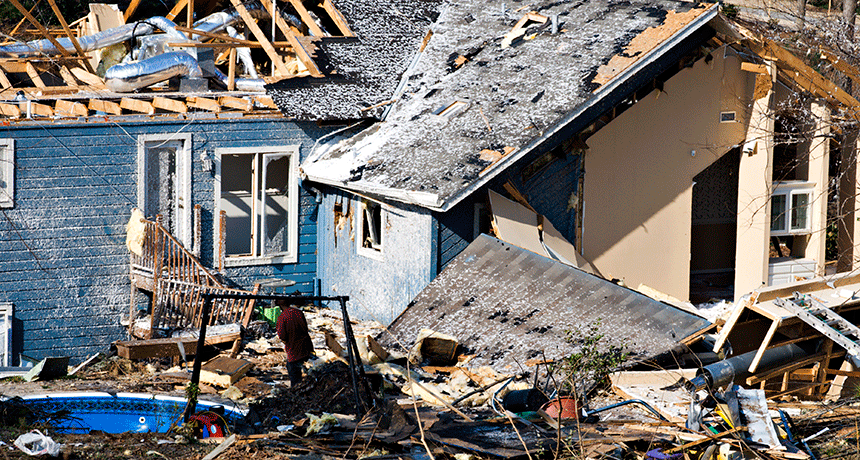
The destructive winds associated with many types of storms can rip the roofs off of homes and other structures. One preteen developed wind-dampening add-ons to protect roofs in wind-prone regions.
LCBallard/iStockphoto
By Sid Perkins
Any world with an atmosphere has wind. Simply put, wind is moving air. Winds can be powerful — which means, in the literal sense, full of power. That’s why a dramatic storm’s winds can rip roofs off of houses. When harnessed by turbines, less turbulent winds can electrify cities and towns. Over the long term, steady streams of wind can sculpt landscapes and ecosystems. Three finalists at this year’s Broadcom MASTERS competition each presented findings on various aspects of powerful winds from their personal research.
Broadcom MASTERS brings together 30 U.S. middle-school students each year to tackle team challenges. (MASTERS stands for Math, Applied Science, Technology and Engineering for Rising Stars.) The program was created by Society for Science & the Public, which publishes Science News for Students. Broadcom Foundation, headquartered in Irvine, Calif., sponsored the event.
Unlike most science competitions, only about one-fourth of a finalist’s overall score is based on the qualifying research that he or she had entered at a science fair the previous school year. Sara Kaufman, 12, Cooper City, Fla., analyzed devices that homeowners might use to protect their roofs during hurricanes. This project helped earn her second place in the mathematics category, valued at $2,500. (The overall, first-place winner for this year’s Broadcom MASTERS took home a $25,000 prize.)
The bad kind of wind power
A hurricane can easily cause billions of dollars of damage to homes and businesses. A lot of that damage will be due to storm surges. That’s when powerful winds drive ocean waters onto shore, flooding coastal regions. But a lot of damage also comes from the storm’s winds. These can topple trees onto homes and blow down walls. They also can damage roofs, she notes.
Sometimes the damage will only be minor; the wind may remove just a few roofing shingles. Other times, Sara notes, hurricane winds can rip the entire roof off of a home. In some storm-prone areas, new homes must be built with hurricane straps. These small strips of steel help attach a home’s roof to its walls. But older homes in those areas typically don’t have these.
It’s difficult to add hurricane straps after a home has been built. That’s because layers of plywood and shingles hide the internal structure of the roof. You’d have to remove the roof to install the straps. And while that’s possible, it would be very expensive. So, Sara said, “I decided to see if I could design something to protect strap-free homes from powerful winds.” She figured her additions would need to attach to the outside of the roof.
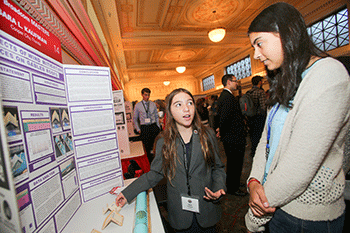
First, she had to come up with design ideas for these add-ons. They would need to interrupt airflow over the roof and reduce the wind’s lifting power. Sara’s simplest idea was to take long boards and add them along the edge of the roof. Those boards would have a slightly rounded edge. That should smooth out the airflow.
Another idea was to make the shape (in cross-section) of the add-ons resemble an airplane’s wing, or airfoil. She reasoned that this might make the airflow smoother still. It also, however, might create lift, just as an airplane’s wing does. That, in turn, might aid winds in ripping a home’s roof off.
Sara’s third notion was to add chimney-like structures to the corners of the roof. Like the boards she designed for her second idea, their shape (in cross-section) would look like an aircraft wing. But they would stand up vertically like corner posts, not be attached all along the edges of the roof.
Engineers often use large wind tunnels to analyze the flow of air around scale models of objects, such as cars and airplanes. For her tests, Sara built a small-scale wind tunnel. Hers was made from a 1.5-meter (5-foot) section of plastic pipe that was about 15 centimeters (6 inches) in diameter. Sara cut a window in the central section of the pipe. Then she covered it in clear plastic so that she could watch what happened during her tests. Small-scale model homes — with and without her new add-ons — were placed in this zone, which scientists call a test section.
A leaf blower then provided the wind power. To make sure its simulated winds blew through the test section without swirling, each end of her tunnel, both upwind and downwind of the test section, was filled with short lengths of very small pipes. The paths through the small pipes helped straighten the flow and reduced turbulence.
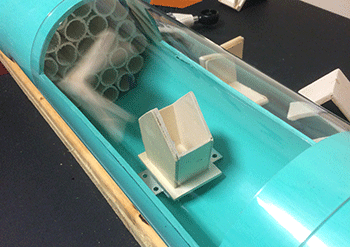
Her leaf blower generated 40-kilometer-per-hour (nearly 25 mile per hour) winds. At the scale of Sara’s wind tunnel, that would be equivalent to the winds in a Category-3 hurricane, she notes. Their winds blow at speeds of at least 178 kph (111 mph).
The model homes Sara tested were actually birdhouses with roofs that could be lifted off. She made and tested four different models of them. “I used balsa wood to make the add-ons,” she said. “It was pretty easy to work with.” She tested all three of her novel designs for roofing add-ons. In addition, she tested one bird house with no changes to its roof. (It was the control for her experiment and represented a regular house.)
Sara then measured how long it took a roof to blow off each model home in the wind-tunnel tests. Compared to the control house, all of her add-ons delayed the roof loss. “But some didn’t help that much,” she noted.
It took only 4.19 seconds, on average, for the roof to blow off of the control house. The add-on boards that used only a rounded edge delayed the roof loss by another 0.12 second. The add-ons with an airfoil-shaped cross section worked better. These kept the roof on 72 percent longer (compared to the control house) — an average of 7.22 seconds. The chimney-like structures added to the corners of a home worked best of all. They kept the roof on the model home for nearly 14 seconds.
In the future, Sara says she’d like to try add-ons with different airfoils. She suspects that shapes other than the one she’s already tested might work even better.
Big wind in the big city
Wind turbines that harness the power of moving air are often very large. For some, the distance across their rotor blades is longer than a football field. Never mind that to generate power efficiently they need to stand in an open area stretching at least three times that distance in every direction. So, a large wind turbine has no place in a crowded city.
But Rachel Pizzolato thinks that maybe a lot of small turbines would work.
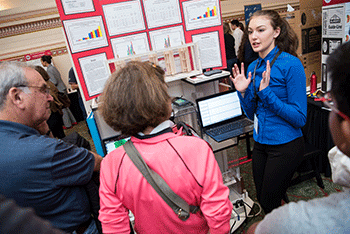
This 13-year-old from Metairie, La., wouldn’t plop them down in parks and vacant lots, though. She proposes attaching them to buildings, or maybe suspending them between buildings. And she wouldn’t give them long whirling blades. Instead, Rachel would install stretched-out versions of the paddlewheels used to power old-timey steamboats. Finally, the axis of each would be vertical, the opposite of those horizontal riverboat paddlewheels.
Placed on or between skyscrapers, such turbines could take advantage of what researchers often call the “urban street canyon” effect. That’s the relatively narrow area between tall buildings where winds often blow faster than they otherwise would because their air is being funneled into a small area, Rachel explains. Although the winds here speed up, they’re also far more turbulent. And that’s the down side. Turbulence could make it difficult to figure out the best spot to place the turbines, she notes.
For now, Rachel is focusing on coming up with the best design for a single turbine. She built and tested several. For some, the blades were pointed out at a 45-degree angle from the outer rim (that’s half of the angle that makes up the corner of a square). For others, the angle was 60 degrees. Rachel tried these two angles to see which would catch more of the available wind.
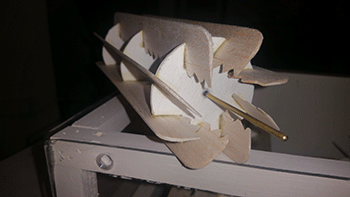
Rachel also varied the design of her turbine’s blades. Some had a blunt front edge. Others were rounded. Still others had rear edges that were wavy. That waviness was intended to mimic the bumps on the front edge of a humpback whale’s flippers, the teen explains. Previous studies had shown that those bumps, or tubercles, help guide the flow of water along the flipper’s surface. And that increases lift.
Like Sara, Rachel tested her designs in a handmade wind tunnel. She crafted scale models of her turbines out of balsa wood (which is strong, light and easily carved). Then she tested the turbines at four wind speeds that ranged from 3.9 to 10 meters per second (about 8.7 to 22.4 miles per hour). No big surprise, some of Rachel’s designs generated more power at these speeds than others. In general, blunt-edged turbines performed the worst. Those with rounded front edges on their blades did better. “The devices whose blades had wavy rear edges did the best,” the teen showed. In her tests, the best turbine design generated twice as much power as the worst one.
Rachel plans to continue tweaking her turbines. To help her more quickly come up with a design that produces peak power, she’ll try 3-D printing her blades. By using that technique, she won’t have to slowly carve bits of wood. Instead, she’ll create a computer model of a blade and then have a special printer build it, layer by layer (probably from some sort of plastic). If one design doesn’t work well, she’ll simply change the computer model to print something different.
Winds shape ecosystems
As many hikers do, 14-year-old Kathryn Kümmel (“Koko”, to her friends) pays a lot of attention to her surroundings. While hiking one of her favorite trails near her home, which is in Colorado Springs, Colo., Koko noticed that the tree line had a weird shape. (A tree line is the elevation above which trees can’t grow due to cold or dryness.) At this site, there wasn’t a clear, smooth line dividing the trees below from the grassy areas above. Instead, there were small islands of trees — usually cone-bearing evergreens — well beyond the edges of the larger masses of trees. In some cases, those isolated tree clumps were 20 to 60 meters (yards) upslope from the tree line.
In some regions, climate change has been causing tree lines to migrate to higher elevations. (As temperatures grow warmer at high elevations, cold-sensitive plants and animals can more readily survive and thrive.) But Koko suspected that winds also might have played a role in sculpting the oddly shaped tree line in her area. So, she did some lab tests and also collected data in the field.
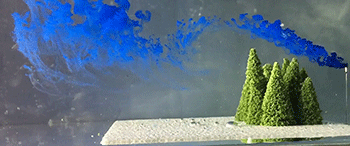
Instead of using a wind tunnel, as Sara and Rachel had, Koko made some models and dragged them through a tank of water. Those tiny model trees were “planted” in a slab of Styrofoam and then turned upside down and submerged in the tank. She released droplets of ink into the water to highlight the flow patterns (her model for wind patterns) that were moving past her tiny models of clumped trees.
These data indicate that winds don’t just flow over and past trees, then move on. Instead, some swirl back into the protected area downwind of the clump. Koko suspects that such wind patterns could affect the buildup of snowdrifts and the scattering of seeds, among other things.
To check this out in the real world, she installed a couple of sophisticated weather stations near one tree island along her favorite hiking route. Those instruments measured things such as temperature, humidity and the wind speeds at two different heights above ground. She placed one station a few meters (yards) upwind of the tree island. She put the other just downwind of the clump.
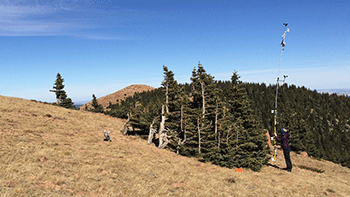
Data from these field sites backed up the results of her water-tank tests. On the upwind side of the clump, wind speeds were higher than on the downwind — or protected — side of the tree island. “That dramatically affected how the trees were shaped,” says Koko. On wind-blasted sides of the trees, especially those along the edge of the clump, branches were shorter and weirdly shaped.
Trees along the upwind edge of the clump weren’t taller than the others. But based on the appearance of their bark, they were older than other trees in the island.
That, in turn, suggests that the older trees’ seeds had been carried downwind. Yet the tree island that Koko studied included only mature trees and not any seedlings. The teen plans to further study the issue. Even though the downwind sides of tree islands are protected from the wind, it’s possible that any snowdrifts that accumulate and persist there may stifle the growth of seedlings.
If you’ve ever watched a weather vane (or simply stood outside on a breezy day), you know that winds are fickle. They arrive from one direction in one moment and then a different one soon after. Not only that, but their speed changes from one moment to the next. Computer models of airflow are either way too crude to give good results, or they’re so complicated they seemingly take forever to run. So, for the near future, scientists and engineers everywhere — including researchers like Sara, Rachel and Koko — will be using wind tunnels and water tanks to make sure that their experiments give consistent results.







